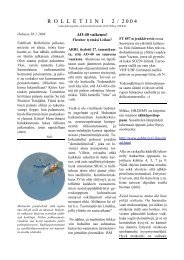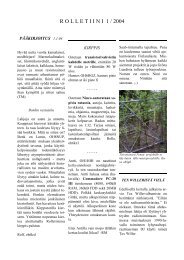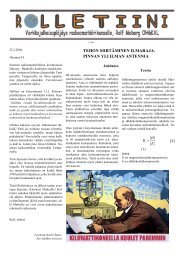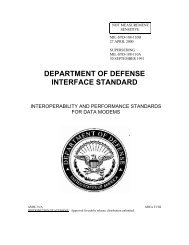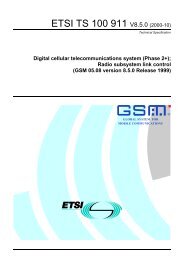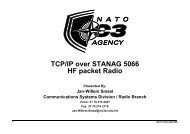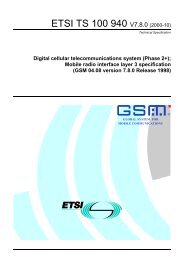nato unclassified - Ham-pages ... No indexes at this level
nato unclassified - Ham-pages ... No indexes at this level
nato unclassified - Ham-pages ... No indexes at this level
Create successful ePaper yourself
Turn your PDF publications into a flip-book with our unique Google optimized e-Paper software.
NATO UNCLASSIFIED<br />
STANAG 5066: PROFILE FOR MARITIME HF DATA COMMUNICATION<br />
V1.0.2<br />
The Radio Equipment Sublayer comprises the equipment required to establish a radio link<br />
between two or more nodes, i.e. transmitters, receivers, transceivers, antennas, etc. This<br />
sublayer is not defined in <strong>this</strong> document. A NATO STANAG (STANAG 4203) exists which<br />
specifies minimum standards for transmitters and receivers.<br />
The Subnet Management Sublayer is shown in Figure 1 as a vertical column with<br />
interfaces to each sublayer. The main subnet management function, in the context of <strong>this</strong><br />
STANAG, is autom<strong>at</strong>ic link maintenance (ALM) in the form of adaptive control of the HF<br />
modem. The management sublayer messages and associ<strong>at</strong>ed procedures which are required<br />
for ALM are defined in Annex C of <strong>this</strong> document, in the context of the MANAGEMENT<br />
D_PDU. The other functions of the Subnet Management Sublayer, which may be critically<br />
important to a successful implement<strong>at</strong>ion, need not be standardized for interoperability and<br />
are not addressed further in <strong>this</strong> document.<br />
AdditionalList of Annexes<br />
Annex A: Subnetwork Interface Sublayer (mand<strong>at</strong>ory)<br />
Annex B: Channel Access Sublayer (mand<strong>at</strong>ory)<br />
Annex C: D<strong>at</strong>a Transfer Sublayer (mand<strong>at</strong>ory)<br />
Annex D: Interface between D<strong>at</strong>a Transfer Sublayer and Communic<strong>at</strong>ions Equipment<br />
(mand<strong>at</strong>ory)<br />
Annex E: HF Modem Remote Control Interface (inform<strong>at</strong>ion only)<br />
Annex F: Subnetwork Client Definitions (inform<strong>at</strong>ion only)<br />
Annex G: Waveforms for D<strong>at</strong>a R<strong>at</strong>es Above 2400 BPS (inform<strong>at</strong>ion only)<br />
Annex H: Implement<strong>at</strong>ion Guide and <strong>No</strong>tes (inform<strong>at</strong>ion only)<br />
Annex I: Messages and Procedures for Frequency Change (inform<strong>at</strong>ion only)<br />
Annex G provides a definition of waveforms which will provide d<strong>at</strong>a r<strong>at</strong>es above 2400 bps.<br />
The mand<strong>at</strong>ory annexes are written to support d<strong>at</strong>a r<strong>at</strong>es up to 9600 bps, however no<br />
standards currently exist for HF modems <strong>at</strong> these d<strong>at</strong>a r<strong>at</strong>es. Annex H provides<br />
implement<strong>at</strong>ion guidance and notes.<br />
References<br />
1. Clark, D., and N. Karavassillis, “Open Systems for Radio Communic<strong>at</strong>ions: A<br />
Subnet Architecture for D<strong>at</strong>a Transmission over HF Radio”, TM-94037 (in prepar<strong>at</strong>ion)<br />
2. Miller, T., and P. Reynolds, “Experience with Approved Cryptographic Equipment in<br />
HF ARQ Systems”, NC3A TN 638, NATO CONFIDENTIAL, <strong>No</strong>vember 1996<br />
NATO UNCLASSIFIED<br />
8




